Ijraset Journal For Research in Applied Science and Engineering Technology
- Home / Ijraset
- On This Page
- Abstract
- Introduction
- Conclusion
- References
- Copyright
Herbal Anti-fungal Cream: A Natural Approach to Onychomycosis Treatment
Authors: Mr. Anuch Ninad Bhavsar, Mr. Pranay Sanjay Bafna, Dr. Javesh K. Patil
DOI Link: https://doi.org/10.22214/ijraset.2024.61406
Certificate: View Certificate
Abstract
Onychomycosis is a frequent fungal infection of the nails that is difficult to cure and is not well controlled by standard medications, therapeutic options are limited. Herbal remedies have drawn interest as a result of this due to their potential as complementary therapies. The composition and effectiveness of a novel herbal anti-fungal cream that combines the powerful anti-fungal qualities of clove oil, turmeric, and pure peppermint are examined in this abstract. The strong anti-fungal properties of clove oil\'s high eugenol content are enhanced by curcumin, an anti-inflammatory and anti-microbial compound found in turmeric. Pure peppermint contributes antifungal and calming qualities as well as a pleasant element. The combination of these components offers a viable way to cure onychomycosis, possibly more effectively than conventional therapies because it is all-natural.
Introduction
I. INTRODUCTION
A fungal infection of the nails known as onychomycosis affects millions of people worldwide and poses a persistent and difficult clinical condition. Traditional therapies, like oral drugs and topical antifungal creams, frequently have poor effectiveness and carry the risk of side effects or drug interactions.
A growing number of people are interested in investigating complementary and alternative therapies, especially those that come from natural sources, in light of these difficulties. Traditional medical systems have traditionally employed herbal treatments due to their perceived safety and effectiveness.
Because of their strong anti-fungal and anti-microbial qualities, clove oil, turmeric, and pure peppermint have become highly promising options for the treatment of onychomycosis.
The component recognized for its broad-spectrum antibacterial activity, eugenol, is abundant in clove oil, which is extracted from the buds of Syzygium aromaticum.
One of the ginger family's rhizomatous herbaceous perennials, turmeric includes curcumin, a polyphenolic chemical that has been shown to have anti-inflammatory and anti-fungal effects. Mentha piperita is the source of pure peppermint, which is extracted and contains menthol and other bioactive ingredients with calming and antifungal properties.
By going over possible mechanisms of action, this research aims to further our knowledge of natural methods of treating onychomycosis.
By investigating the potential of herbal remedies as a therapeutic tool and encouraging more research into their application to the treatment of onychomycosis, our goal is to provide patients suffering from this common fungal infection with safe, efficient, and easily accessible treatment options. (1-2).
A. Onychomycosis
Fingernails and toenails that have onychomycosis, a fungal disease, get thicker, darker, and split from the nail bed. Even if 10% of people worldwide are affected, adults are more likely to encounter it. Onychomycosis is 1.9–2.8 times more common in diabetics than in the general population, and 15%–40% of HIV-positive persons have the disease.
Proximal sublingual onychomycosis, which often spreads from the proximal nail folds, and distal subungual onychomycosis, which affects the nail plate, bed, and hyponychium, are the two main types of onychomycosis that are currently recognized to exist. Clinical variations include the less common superficial white variety and the endonyx type, which does not include hyperkeratosis or onycholysis. (3-4).
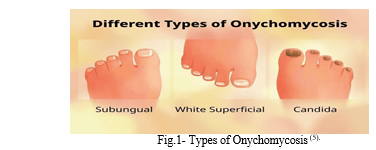
- Symptoms
The majority of fungal nail infections are harmless. However, some people could find their nails uncomfortable or bothersome. Infections with nail fungi can cause thick, brittle, cracked, or discoloured nails. Additionally, the nail may separate from the nail bed. Athletes' foot, ringworm on the foot, or tinea pedis are common names for fungal skin infections that frequently coexist with fungal toenail infections. (6).
2. Epidemiology
In post-industrialized countries, almost 10% of people suffer with onychomycosis. The prevalences reported in studies conducted in Finland (n = 800) and Canada (n = 2001; n = 15,000) ranged from 6.5% to 9.1%. Although at first thought to be unimportant, there have allegedly been more cases in subsequent years. The frequency was 2.18% in 1979 US research (n = 20,000), and it increased to 1038 by 1997. An increase from 3.5% in 1997–1998 to 4.7% in 2003 was seen in an Indonesian study. The Achilles study conducted surveys with people in East Asia (n = 43,914) and Europe (n = 22,760), and the results showed significant prevalences of 26% and 22%, respectively. (7-8).
3. Nail anatomy and Physical Characteristics
The nail unit consists of anatomical structures such the hyponychium, which serves as a barrier of protection at the free edge of the nail plate. The nail unit is mostly composed of the nail matrix, with a small amount of input from the nail bed. The nail plate is 0.5–1.0 mm thick and consists of dorsal, intermediate, and ventral layers. Hard keratin makes up the majority of this plate. Where it originated in the matrix is indicated by the lunula. While fingernails grow at a pace of 3 mm per month, depending on circumstances including gender, temperature, pregnancy, and mild traumas, toenails develop at a rate of about 1 mm per month. Levodopa, antifungal drugs, calcium/vitamin D, and other treatments can speed up nail development, which may help treat onychomycosis. Nevertheless, inadequate medication penetration through the nail plate reduces the effectiveness of traditional topical antifungal treatments. Tineapedis was not often seen in Europe prior to the arrival of T. rubrum because of increased population mobility brought on by many world wars and significant migration. Due to its proliferation, the US saw its first clinical instance of tineapedis after World War I, and in 1928 it saw the first case of onychomycosis. Tineapedis and onychomycosis have been more common in the 20th century due to factors such as population mobility, occlusive footwear use, increased fitness activities, World War II, and Vietnam War. As the most prevalent dermatophyte in the world, T. rubrum has surpassed T. mentagrophytes; around 70% of Americans have dermatophytic fungi on their plantar surfaces. (9-11).
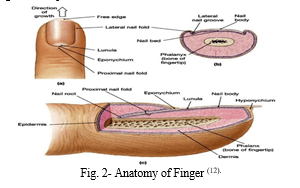
B. Morphology and Clinical Presentation
Based on the manner and location of fungal invasion of the nail plate, onychomycosis is classified into five types: total dystrophic onychomycosis, proximal subungual, endonyx, distal and lateral subungual, and superficial white.
- Distolateral Onychomycosis
The most prevalent type, called distolateral subungual onychomycosis, begins frequently at the hyponychium and moves through the lateral groove or the distal-lateral edges from the distal to the proximal nail matrix. The infection is typically caused by Trichophyton spp., although it can also be caused by Scytalidium spp., Candida spp., and other non-dermatophytes. Paronychia, subungual hyperkeratosis, onycholysis, and thicker nails are some of its symptoms. The nail plate may get discolored a yellow color due to the presence of pathogenic bacteria and fungus in the subungual region. (13).
2. Proximal Subungual Onychomycosis
Even though it is less common, proximal subungual onychomycosis is more common among AIDS patients and others with weakened immune systems, and it frequently acts as a preliminary clinical indicator of HIV infection. This type is frequently linked to T. rubrum, C. albicans, Fusarium spp., Aspergillus spp., and Scopulariopsis brevicaulis. Under the nail cuticle, fungi infiltrate the nail, causing infection in the proximal nail plate and spreading laterally throughout the nail.
3. Superficial white Onychomycosis
Onychomycosis superficialis affects the dorsal aspect of the nail plate, resulting in regions of opaque white nail plate discoloration. The principal pathogens are Trichophytonmentagrophytes and T. rubrum, while non-dermatophyte molds such as Aspergillus spp., Fusarium spp., and Acremonium spp. have also been discovered. The upper layers of the nail's keratin are home to the majority of fungal components.
???????4. Endonyx onychomycosis
A newly discovered variation of the disease known as endonyx onychomycosis is typified by fungal invasion of the nail plate's deeper layers in addition to its surface. There are no inflammatory alterations, lifting, or thickening of the nails like in other forms. The main culprits are T. violaceum and T. soudanense. Lamellar cracking, coarse pitting, and milky white patches inside the afflicted nail plates are characteristics of this fungal nail infection.
???????5. Total dystrophic onychomycosis:
The final stage of chronic onychomycosis is called total dystrophic onychomycosis, and it is frequently marked by almost total disintegration of the infected nail plate. Complete dystrophic onychomycosis is recognized to have two subtypes: main and secondary. Individuals with primary full dystrophic onychomycosis are typically those who have persistent mucocutaneous candidiasis. (14).???????
C. Herbs for onychomycosis Treatment
One of the oldest and most popular forms of medicine, herbal therapy, has recently benefited from improvements in medication delivery to effectively treat human illnesses. According to data from the World Health Organization (WHO), 80% of people worldwide today receive their primary care from herbal medicine. More and more countries are looking into alternative forms of healthcare, such as herbal cures for self-medication. Scientific facts, clinical experience, understanding of medical science, and traditional knowledge are all integrated in modern herbal therapy. People are gradually turning to alternative medicine. (15).
- Advantages of Herbal System of Medicines
a. Less chance of adverse effects.
b. Broad accessibility.
c. Performance in long-term care.
d. Their low cost of operation makes them even more enticing.
e. Herbal medicine effectively promotes the body's natural detoxification process.
f. Herbal medications have fewer adverse effects and are gentler.
2. Disadvantages of Herbal System of Medicines
a. Bulk dosing.
b. Instable in more acidic pH, metabolism in the liver, etc.
c. A large molecule size that prevents passive diffusion absorption.
d. A large quantity of raw materials are needed to process the medication.
e. The medicinal efficacy of a whole herbal extract may be partially or completely lost when specific components are separated and purified.

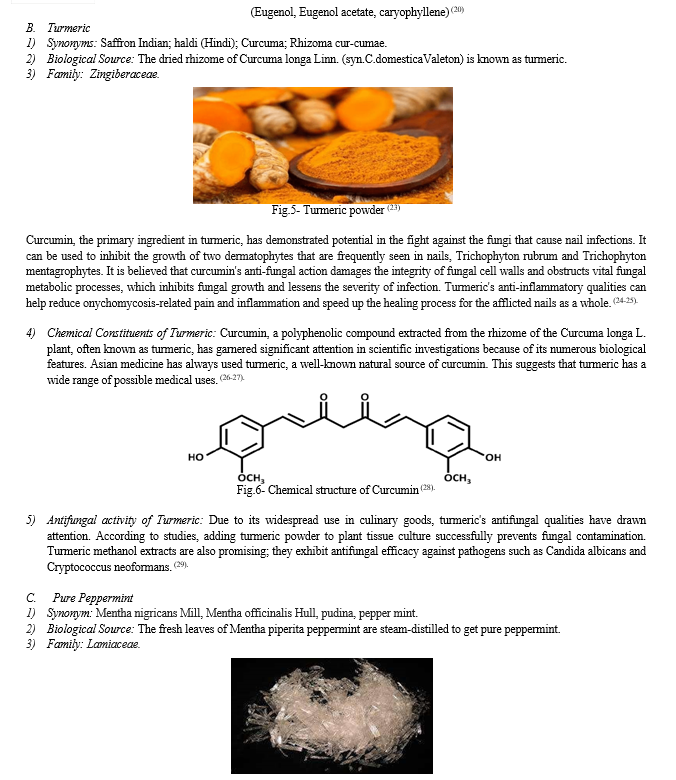
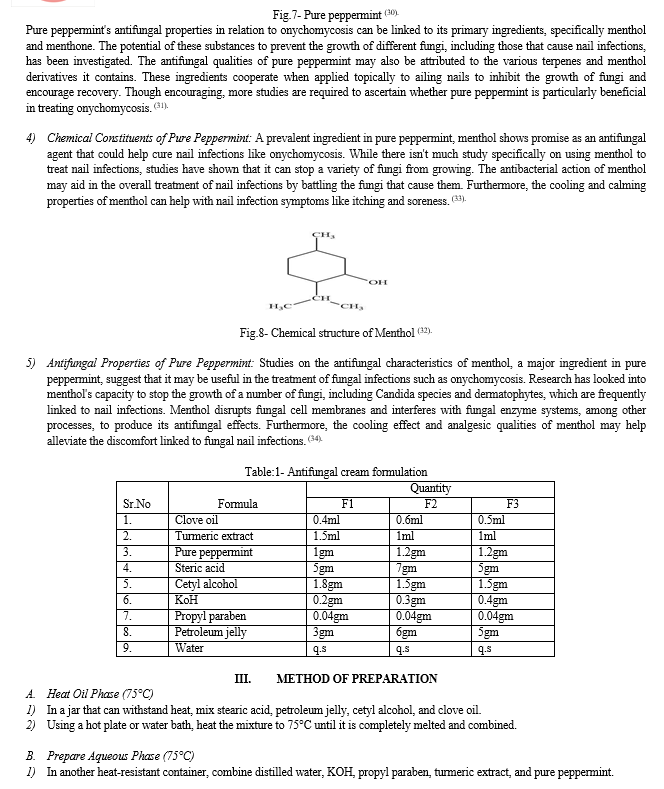
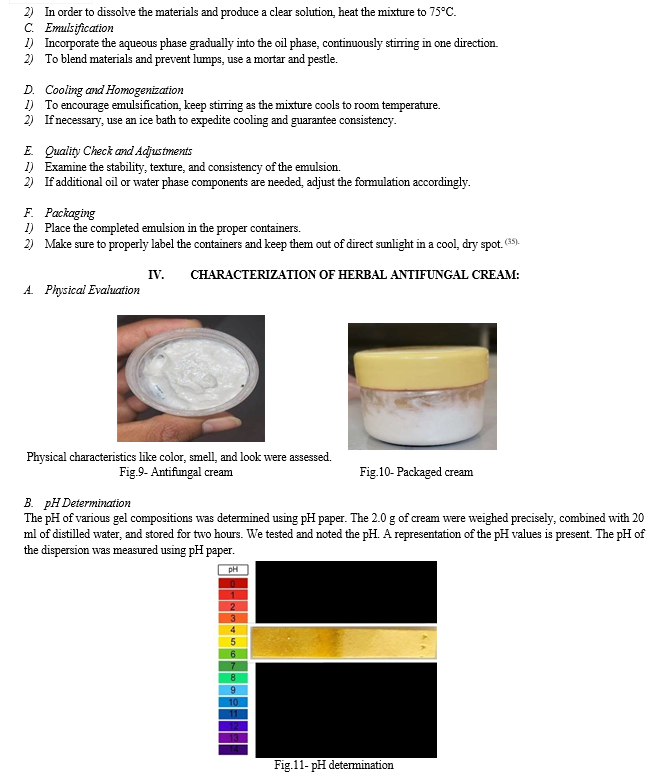
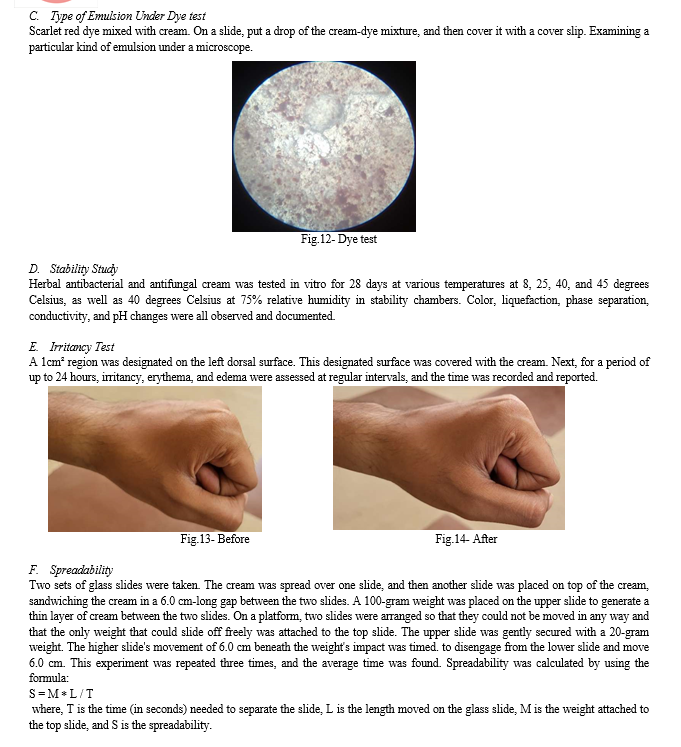
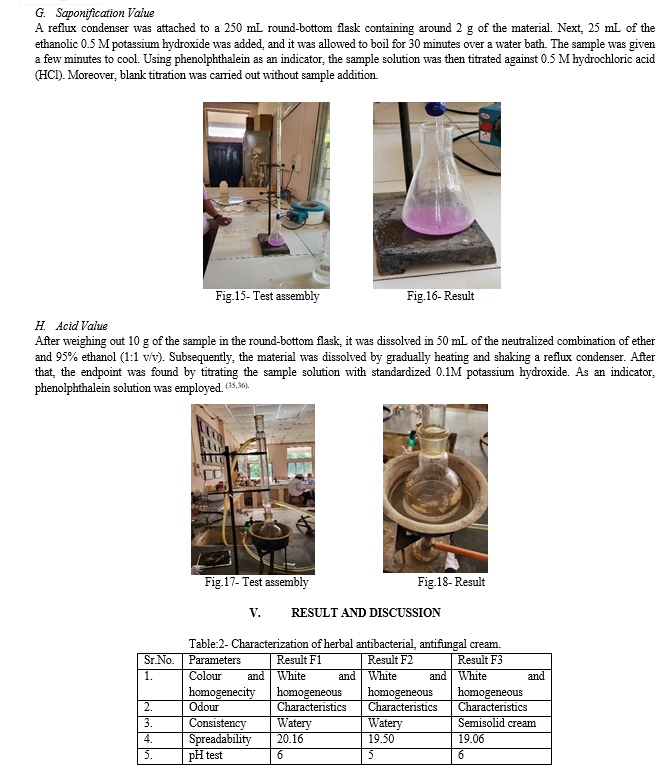

I. Discussion
The evaluation parameters applied to the cream produced a number of noteworthy conclusions. For example, the cream with the label F3 was white in color, had a distinct smell, and was semisolid in consistency, whereas the creams with the labels F1 and F2 were runny. Additionally, all three formulations (F1, F2, and F3) showed good spreadability and a pH of 6. Furthermore, none of the formulations showed any indications of irritation. In addition, all formulations were found to have good washability, with no phase separation observed. Nevertheless, it was shown that F1, F2, and F3 were unstable in freezing conditions but stable at ambient temperature throughout the cyclic temperature research.
Conclusion
In conclusion, Clove oil, turmeric, and pure peppermint make up a natural anti-fungal cream that shows promise in treating onychomycosis, a common and difficult-to-treat nail fungal infection. This herbal treatment successfully fights fungal diseases by utilizing the combined antibacterial qualities of its constituents, treating the illness as well as any accompanying symptoms. Our study has shown that the cream is effective in preventing the growth of common fungal species linked to onychomycosis, indicating that it may be a safe and effective therapy alternative. Moreover, clove oil, turmeric, and pure peppermint have anti-inflammatory and calming qualities that help to reduce discomfort and support healthy nails during the therapy process. This herbal cream can address concerns about side effects and medication resistance while providing a natural substitute for conventional antifungal therapies. It also appeals to those who prefer holistic and plant-based remedies. Furthermore, using it topically offers a practical and non-invasive way to treat onychomycosis, which may improve patient compliance and treatment results.
References
[1] Shields B.E., Rosenbach M., Brown-Joel Z., Berger A.P., Ford B.A., Wanat K.A. Angioinvasive fungal infections impacting the skin: Background, epidemiology, and clinical presentation. JAAD. 2019;80:869–880. [2] Lipner SR, Scher RK: Onychomycosis: Treatment and prevention of recurrence. J Am AcadDermatol. 2019;80(4):853–67. [3] Elewski BE: Onychomycosis: pathogenesis, diagnosis, and management. ClinMicrobiol Rev. 1998;11(3):415–29. [4] Gupchup GV, Zatz JL: Structural characteristics and permeability properties of the human nail: A review. J Cosmet Sci. 1999;50(6):363–385. [5] https://images.app.goo.gl/C1LjvoPaqcS8mJma6 (Accessed on date 12/09/2023). [6] Baran R, editor: Baran&Dawber’s diseases of the nails and their management. Fifth edition. Hoboken, NJ: Wiley-Blackwell;2019. [7] Rock FL, Mao W, Yaremchuk A, et al.: An antifungal agent inhibits an aminoacyl-tRNAsynthetase by trapping tRNA in the editing site. Science. 2007;316(5832):1759–61. [8] Wang, Bin (2016). \"Keratin: Structure, mechanical properties, occurrence in biological organisms, and efforts at bioinspiration\" (PDF). Progress in Materials Science. 76: 229–318. [9] Onumah, Neh; Scher, Richard K (May 2009). \"Nail Surgery\". eMedicine. Retrieved 10 March 2010. [10] Feneis, Heinz (2000). Pocket Atlas of Human Anatomy (4th ed.). Thieme. pp. 392–95. [11] \"Nail matrix\". Biology Online. 2005. Retrieved 10 March 2010. [12] https://images.app.goo.gl/C419Qt94HRvVb6Wx5 (Accessed on date 13//09/2023). [13] D. Schoon, Dougles (2005). Nail Structure and Products Chemistry. Milady. p.6. [14] Elsevier, Dorland\'s Illustrated Medical Dictionary, Elsevier. [15] Pyun M, Shin S. Antifungal effects of the volatile oils from Allium plants against Trichophyton species and synergism of the oils with ketoconazole. Phytomedicine. 2006;13:394–400. [16] https://images.app.goo.gl/CzMRuWJfg2MTPrYG6 (Accessed on date 20/09/2023). [17] Arras G., Usai M. Fungitoxic activity of essential oils against four post- harvest citrus pathogens: Chemical analysis of Thymus capitates oil and its effect in sub-atmospheric pressure conditions. J. Food Prot. [18] Ayoola G.A., Lawore F.M., Adelowotan T., Aibinu I.E., Adenipekun E., Coker H.A.B., Odugbemi T.O. Chemical analysis and antimicrobial activity of the essential oil of Syzigiumaromaticum (clove) African J. Microbiol. Res. 2008;2:162–166. [19] Cai L., Wu C.D. Compounds from Syzygiumaromaticum processing growth inhibitory activity against oral pathogens. J. Nat. Prod. 1996;59:987–990. [20] https://images.app.goo.gl/mBcQSFLjXUBAHF347 (Accessed on date 20/09/2023). [21] Harbone J.B. 3. USA: Chapman and Hall, PA; 1998. Essential oils. In: Phytochemical Methods: A guide to modern techniques in plant analysis; pp. 110–124. [22] Hostettmann K. Strategy for the biological evaluation of plant extracts. Pure App. Chem. 1999;70:1109–1113. [23] https://images.app.goo.gl/ocETPQHuJTt62ztN9 (Accessed on date 26/09/2023). [24] Balasubramanyam K, Varier RA, Altaf M, et al. Curcumin, a novel p300/CREB-binding protein-specific inhibitor of acetyltransferase. The Journal of Biological Chemistry. 2004;279(49):51163–51171. [25] James JS. Curcumin: clinical trial finds no antiviral effect. AIDS Treatment News. 1996;(242):1–2. [26] Chen D-Y, Shien J-H, Tiley L, et al. Curcumin inhibits influenza virus infection and haemagglutination activity. Food Chemistry.2010;119(4):1346–1351. [27] De R, Kundu P, Swarnakar S, et al. Antimicrobial activity of curcumin against helicobacter pylori isolates from India and during infections in mice.1592–1597. [28] https://www.researchgate.net/figure/Chemical-structure-of-curcumin-a-polyphenolic-chemical-constituent-of-turmeric-with_fig1_344808208 (Accessed on date27/09/2023). [29] Foryst-Ludwig A, Neumann M, Schneider-Brachert W, Naumann M. Curcumin blocks NF- ?B and the motogenic response in Helicobacter pylori 2004;316(4):1065–1072. [30] https://images.app.goo.gl/URSxTGc2ZXgJTrc3A (Accessed on date 29/04/2024). [31] Tullio V, Roana J, Scalas D, Mandras N. Evaluation of the Antifungal Activity of Mentha x piperita (Lamiaceae) of Pancalieri (Turin, Italy) Essential Oil and Its Synergistic Interaction with Azoles. Molecules. 2019 Aug 29;24(17):3148. doi: 10.3390/molecules24173148. PMID: 31470602; PMCID: PMC6749244. [32] https://images.app.goo.gl/t7oro92NKjb2Hn6w6 (Accessed on date 29/04/2024). [33] Tariq S., Wani S., Rasool W., Shafi K., Bhat M.A., Prabhakar A., Shalla A.H., Rather M.A. A comprehensive review of the antibacterial, antifungal and antiviral potential of essential oils and their chemical constituents against drug-resistant microbial pathogens. Microb.Pathog. 2019;134:103580. doi: 10.1016/j.micpath.2019.103580. [34] Sokovi? M.D., Vukojevic J., Marin P.D., Brki? D.D., Vajs V., Van Griensven L.J.L.D. Chemical Composition of Essential Oils of Thymus and Mentha Species and Their Antifungal Activities. Molecules. 2009;14:238–249. doi: 10.3390/molecules14010238. [35] Bhavani, M. S., Naveena, C., Nagamani, P., & Sowmya, B. (2023, December). Formulation and Evaluation of Herbal Face Cream. International Journal of Pharmaceutical Sciences Review and Research, 83(2). https://doi.org/10.47583/ijpsrr.2023.v83i02.011. [36] S., V., KAUR, S., & KULKARNI, G. (2021, September 15). FORMULATION AND EVALUATION OF ANTIFUNGAL CREAM OF CHLORPHENESIN. International Journal of Current Pharmaceutical Research, 76–81. https://doi.org/10.22159/ijcpr.2021v13i5.1898.
Copyright
Copyright © 2024 Mr. Anuch Ninad Bhavsar, Mr. Pranay Sanjay Bafna, Dr. Javesh K. Patil. This is an open access article distributed under the Creative Commons Attribution License, which permits unrestricted use, distribution, and reproduction in any medium, provided the original work is properly cited.

Download Paper
Paper Id : IJRASET61406
Publish Date : 2024-05-01
ISSN : 2321-9653
Publisher Name : IJRASET
DOI Link : Click Here
 Submit Paper Online
Submit Paper Online

